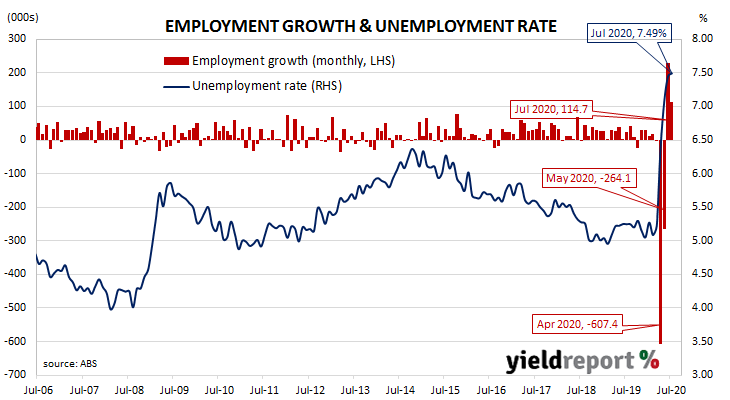Summary: Unemployment rate continues rise; June job gains revised up; employment number rises more than expected; part-time, full-time jobs both up; participation rate increases for second consecutive month; work hours rise more than employment over month; underemployment rate eases for third consecutive month; Victorian workers, businesses likely to suffer restriction effects in August, September; flow-on effects elsewhere expected.
Australia’s period of falling unemployment came to an end in early 2019 when the jobless rate hit a low of 4.9%. It then averaged around 5.2% through to March 2020, bouncing around in a range from 5.1% to 5.3%. Readings of leading indicators such as ANZ’s Job Ads survey and NAB’s capacity utilisation estimate suggested the unemployment rate would rise and it did. Recent improvements in these variables suggest the unemployment rate may soon cease rising. Even so, the RBA’s August Statement on Monetary Policy contained forecasts of a rise in the jobless rate to 10% by the end of 2020.
The latest Labour force figures have now been released and they indicate the number of people employed in Australia increased by more than economists had expected. The report showed the total number of people who held a job according to ABS definitions rose by 114,700 in July, about half of June’s 228,400 increase after it was revised up from 210,800. However, the unemployment rate rose from June’s 7.4% to 7.5%.
“Part-time entirely led the recovery again but full-time also started to recover,” said UBS economist George Tharenou.
Market expectations prior to the report’s release were for about 30,000 positions to be added and for the unemployment rate to rise to 7.8%. Domestic Treasury bond yields fell at the long end of the curve, ignoring upward movements by their US counterparts in overnight trading. By the end of the day, the 10-year ACGB yield had shed 3bps to 0.91% and the 20-year yield had lost 4bps to 1.47%. The 3-year ACGB yield remained unchanged at 0.31%.
In the cash futures market, expectations of a change in the actual cash rate, currently at 0.13%, continued to remain low. By the end of the day, contracts implied the cash rate would remain in a range of 0.125% to 0.135% through to the latter part of 2021.

